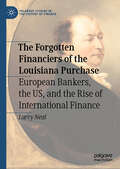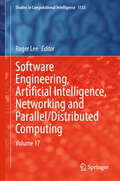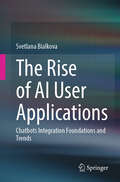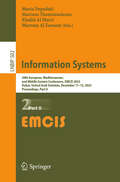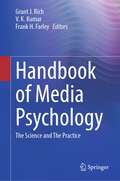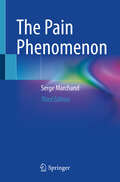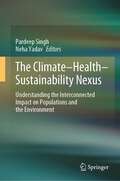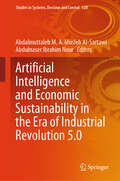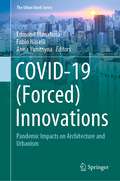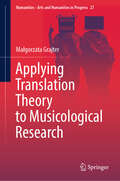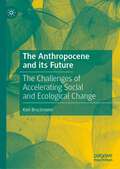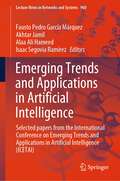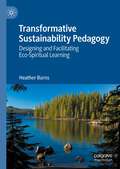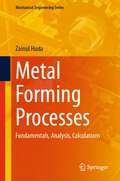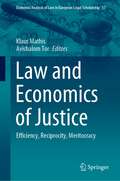- Table View
- List View
The Forgotten Financiers of the Louisiana Purchase: European Bankers, the US, and the Rise of International Finance (Palgrave Studies in the History of Finance)
by Larry NealThis book provides a comprehensive account of how the Louisiana Purchase of 1803 was financed. Where existing research has focused predominantly on the political and diplomatic significance of the Purchase, this book demonstrates the importance of the Purchase to global financial history. The book provides context and background for the Louisiana Purchase and examines the role of key actors and companies, focusing particularly on the ‘forgotten financiers’ of the Purchase – individuals from the US, France and the UK including Alexander Baring, Albert Gallatin, Pierre Cesar Labouchere and Francois Barbe-Marbois. Based on extensive, original archival research, the chapters will illuminate the role played by these individuals in bringing about financial innovation and facilitating a major transaction that doubled the size of the original United States and helped set the country on a path to global power. The book will be a valuable resource for historians of Europe and America, particularly those with interests in economic and financial history, as well as banking and finance scholars who are interested in the emergence of large-scale international finance in the 19th century.
Hierarchical Archimedean Copulas (SpringerBriefs in Applied Statistics and Econometrics)
by Ostap Okhrin Jan GóreckiThis book offers a thorough understanding of Hierarchical Archimedean Copulas (HACs) and their practical applications. It covers the basics of copulas, explores the Archimedean family, and delves into the specifics of HACs, including their fundamental properties. The text also addresses sampling algorithms, HAC parameter estimation, and structure, and highlights temporal models with applications in finance and economics. The final chapter introduces R, MATLAB, and Octave toolboxes for copula modeling, enabling students, researchers, data scientists, and practitioners to model complex dependence structures and make well-informed decisions across various domains.
Dark Academe: Capitalism, Theory, and the Death Drive in Higher Education (Palgrave Studies on Global Policy and Critical Futures in Education)
by Jeffrey R. Di LeoThis book argues that a critical understanding of dark academe is vital to the futures of democracy and education. Drawing upon contemporary literary and cultural theory, particularly, affect theory, queer epistemology, and critical race theory as well as critiques of capitalism and accounts of the death drive, it builds a case for identifying dark academe as anything that prohibits the pursuit of democratic education and critical citizenship. It also argues that dark times require a reassessment of the ways theory and knowledge are approached in the humanities. This is necessary if the aim is to truly understand the darkness at the heart of the higher education today. Dark academe works to negate education and learning by continuously telling us that the quest for knowledge is empty, and the pursuit of critique is blind. In this educational darkness, the death drive of neoliberal academe becomes a force that works against intellectual transformation and the deepening of critical sights.
Assessment Analytics in Education: Designs, Methods and Solutions (Advances in Analytics for Learning and Teaching)
by Dirk Ifenthaler Muhittin SahinThis book is about the current state of research in online assessment. The growth of this field is set to accelerate exponentially with emerging opportunities for automatic data collection and analysis. Yet, the future of online assessment faces major challenges including, perhaps most importantly, the extent to which assessments, when enabled by technology, can serve simultaneously the needs of learners, teachers and those of the enterprise of education. This book details, specifically, the multiple ways in which online assessment can be utilized, such as:Providing virtual coaching or tutoringOffering appropriate scaffoldingAllowing analysis of student decision-making Providing the mechanism for students to review and comment on each others digital creationsCreating a space for online discussionProviding expert coaching for modeling and animation workWith the increased availability of vast and highly varied amounts of data from learners, teachers, learning environments, and administrative systems within educational settings, further opportunities arise for advancing pedagogical assessment practice (Ifenthaler et al., 2018). This book fully details these opportunities, as well as privileges and constraints of analytics-enhanced assessment, harnessing formative as well as summative data from learners and their contexts in order to facilitate learning processes in near real-time and help decisionmakers to improve learning environments.
Software Engineering, Artificial Intelligence, Networking and Parallel/Distributed Computing: Volume 17 (Studies in Computational Intelligence #1153)
by Roger LeeThis book reports state-of-the-art results in Software Engineering, Artificial Intelligence, Networking and Parallel/Distributed Computing. This edited book presents original papers on both theory and practice. It addresses foundations, state-of-the-art problems and solutions, and crucial challenges.
Fundamental Mathematical Concepts for Machine Learning in Science
by Umberto MichelucciThis book is for individuals with a scientific background who aspire to apply machine learning within various natural science disciplines—such as physics, chemistry, biology, medicine, psychology and many more. It elucidates core mathematical concepts in an accessible and straightforward manner, maintaining rigorous mathematical integrity. For readers more versed in mathematics, the book includes advanced sections that are not prerequisites for the initial reading. It ensures concepts are clearly defined and theorems are proven where it's pertinent. Machine learning transcends the mere implementation and training of algorithms; it encompasses the broader challenges of constructing robust datasets, model validation, addressing imbalanced datasets, and fine-tuning hyperparameters. These topics are thoroughly examined within the text, along with the theoretical foundations underlying these methods. Rather than concentrating on particular algorithms this book focuses on the comprehensive concepts and theories essential for their application. It stands as an indispensable resource for any scientist keen on integrating machine learning effectively into their research. Numerous texts delve into the technical execution of machine learning algorithms, often overlooking the foundational concepts vital for fully grasping these methods. This leads to a gap in using these algorithms effectively across diverse disciplines. For instance, a firm grasp of calculus is imperative to comprehend the training processes of algorithms and neural networks, while linear algebra is essential for the application and efficient training of various algorithms, including neural networks. Absent a solid mathematical base, machine learning applications may be, at best, cursory, or at worst, fundamentally flawed. This book lays the foundation for a comprehensive understanding of machine learning algorithms and approaches.
The Rise of AI User Applications: Chatbots Integration Foundations and Trends
by Svetlana BialkovaThis monograph introduces readers to core theories and applications in the chatbot AI context. Although AI is attracting significant attention, there is a literature gap and lack of practical guidelines on the key drivers of chatbot efficiency and agency capacity. There is a caveat between algorithmic explanations and actionable understanding, despite the acknowledged importance of inherently human-centric properties. Addressing these gaps, this state-of-the-art book offers a distinctive combination of content, theory, practice evaluation, and a holistic framework encompassing cognitive, emotional and social aspects, focusing on how to enhance AI agency and user experience. The framework aims to drive design, encouraging development of intelligent systems, techniques to evaluate chatbot with purposes, to appropriately meet user needs and market demand for responsible and explainable AI, XAI. Avenues for transforming business and life by implementing new generation AI systems are further discussed, as well as recommendations to overcome consumer resistance and advice for policy measures to reduce risks given the AI boost. While the community is still in an exploratory mode, we hope “The Rise of AI User Applications: Chatbots Integration Foundations and Trends” provides the needed understanding and will inspire researchers across disciplines to combine their efforts and work together on this very intriguing topic.
Information Systems: 20th European, Mediterranean, and Middle Eastern Conference, EMCIS 2023, Dubai, United Arab Emirates, December 11-12, 2023, Proceedings, Part II (Lecture Notes in Business Information Processing #502)
by Marinos Themistocleous Khalid Al Marri Maria Papadaki Marwan Al ZarouniThis book constitutes selected papers from the 20th European, Mediterranean, and Middle Eastern Conference, EMCIS 2023, which was held in Dubai, UAE, during December 11-12, 2023. EMCIS covers technical, organizational, business, and social issues in the application of information technology and is dedicated to the definition and establishment of Information Systems (IS) as a discipline of high impact for IS professionals and practitioners. It focuses on approaches that facilitate the identification of innovative research of significant relevance to the IS discipline following sound research methodologies that lead to results of measurable impact. The 43 papers presented in this volume were carefully reviewed and selected from a total of 126 submissions. They were organized in topical sections as follows: Part I: Metaverse; blockchain technology and applications; digital governance; healthcare information systems; artificial intelligence; Part II: Big data and analytics; digital services and social media; innovative research projects; managing information systems; smart cities.
Handbook of Media Psychology: The Science and The Practice
by Grant J. Rich V. K. Kumar Frank H. FarleyThis comprehensive and up-to-date resource presents the state of the science in the expanding and widely influential field of media psychology and technology. Covering theoretical concepts, research, and practice, this handbook explores key areas relevant to developing media psychology and technology in today's world.The impact of media and technology is discussed as are the uses and misuses of various media outlets, including television, film, and social media. How media affects public opinion and attitudes is given special attention, as are psycho-social and neuropsychological factors. The authors are recognized experts in this field, many associated with the American Psychological Association’s Society of Media Psychology and Technology. This relevant and timely handbook provides researchers and academics with rich wide-ranging presentations of an area critical to the dissemination and discussion of results and implications of ongoing scientific investigations for bringingabout social change in democratic societies through the use of media and technology.
The Pain Phenomenon
by Serge MarchandIntroducing the latest edition of The Phenomenon of Pain: A Comprehensive Exploration of Pain Mechanisms and Therapeutic Approaches.In recent decades, pain has emerged as a focal point in both basic and clinical research, reflecting its profound impact on individuals' lives. The rapid advancement of knowledge has deepened our understanding of the complex neurophysiological and psychological mechanisms underlying pain, shedding light on its multifaceted nature. Clinicians grapple daily with the daunting reality of human suffering, navigating its intricate web of causes and manifestations. This continuous engagement with pain presents significant and stressful challenges from the relentless pursuit of understanding and alleviating it. This book transcends mere discourse on the physiological and psychological underpinnings of pain; it delves into the intricate factors contributing to its persistence. Furthermore, it meticulously examines pharmacological and nonpharmacological treatment modalities, forging a crucial link between the mechanisms of pain and therapeutic interventions.By bridging the gap between pain mechanisms and treatment strategies, this edition equips clinicians with invaluable insights to augment their clinical acumen. Armed with this knowledge, clinicians can tailor interventions to effectively address the diverse array of pain presentations encountered in their practice.
Academic Research in Business and the Social Sciences: A Guidebook for Early Career Researchers
by George P. MoschisThis book provides doctoral students, junior faculty and early-career researchers with guidelines, resources and strategies for performing and publishing academic research successfully. It helps increase the productivity of researchers by showing efficient and effective ways to increase research output and publication probability, ranging from manuscript preparation and positioning to working with co-authors and journal reviewers. The author uses research findings, anecdotal evidence and illustrations from his academic career to support his views on strategies and tactics that are required of scholars in order to succeed.
Driving Forensic Innovation in the 21st Century: Crossing the Valley of Death
by Simona Francese Roberto S. P. KingThis contributed volume offers a comprehensive and multifaceted understanding of the current forensic innovation, landscape, enablers, road blockers, and barriers to implementation. It also presents all aspects that need consideration to cross the valley of death between an idea and its successful implementation. It uniquely merges the technical and scientific aspects of some of the innovations that have been implemented across forensic science within the National and International landscape and with i) the necessary considerations to take into account on the road to success, such as business planning, data privacy, and legal and regulatory aspects, ii) the end-users perspective and iii) the industry perspective. Case studies illustrate "what success looks like" by discussing forensic innovations that have made it to the market and have subsequently impacted positively on criminal investigations. This book acts as a platform to facilitate the dialogue between key stakeholders in driving innovation namely academia, industry, and end-users as well as indicating a roadmap to facilitate practical developments, whilst serving as a revolutionary springboard to initiate an innovation-transforming paradigm shift. This volume is a valuable contribution to the field and is of great interest to graduates and researchers engaged in forensic science, forensic service providers and manufacturers as well as policymakers.
The Climate-Health-Sustainability Nexus: Understanding the Interconnected Impact on Populations and the Environment
by Neha Yadav Pardeep SinghIn a compelling scholarly journey, this book unfolds the intricate narratives of human progress and its environmental repercussions catalyzed by the Industrial Revolution. It thoughtfully contrasts the exploitative environmental ideologies stemming from colonization and industrialization against the profound yet often marginalized indigenous ecological philosophies, urging a pivotal shift in environmental stewardship. The narrative meticulously traces the arc of scientific discovery and environmental policy evolution, from Eunice Foote’s groundbreaking hypothesis on the greenhouse effect to the landmark achievements of the Paris Agreement, encapsulating over a century of environmental activism and scholarly debate. The discourse extends beyond traditional environmental concerns, exploring the intersection of climate change with public health, food security, and gender disparities, underscoring the urgency of sustainable agricultural practices and the pivotal role of women in food systems. It introduces the transformative potential of digital health innovations and renewable energy technologies as crucial tools in climate mitigation, highlighting the need for an integrated socio-technical governance model that includes community resilience and biopsychosocial health. The book critically addresses the dynamics of climate finance, advocating for inclusive green growth through strategic renewable energy investments, and revisits the ‘Tragedy of the Commons’ to challenge conventional views on communal resource management. It advocates for a justice-oriented approach to tackling the multifaceted environmental, social, and economic challenges, with a particular lens on the adverse impacts borne by marginalized communities in the Global South. Furthermore, it explores the untapped potential of wild genetic resources in bolstering food security. It aligns with the United Nations’ Sustainable Development Goals, advocating for integrating Indigenous wisdom into urban development strategies. This book is a call to action, serving as a comprehensive scholarly examination that addresses the multifaceted challenges of climate change, health, and sustainability and champions a collective approach towards forging a sustainable and equitable future.
Artificial Intelligence and Economic Sustainability in the Era of Industrial Revolution 5.0 (Studies in Systems, Decision and Control #528)
by Abdalmuttaleb M. A. Musleh Al-Sartawi Abdulnaser Ibrahim NourIndustry 5.0 has been dubbed as the digital revolution with a soul. This book incorporates a wealth of research which integrates artificial intelligence (AI) with economic sustainability and Industry 5.0. It examines the human-centricity of the upcoming digital revolution and the role of sustainable technologies in enhancing the livelihoods of workers, individuals, communities, and eventually societies. It provides insight on important areas related to artificial intelligence, sustainable development, and society 5.0. The chapters present a wide range of topics including block cipher, entrepreneurship and AI, AI and stock trading decisions, digital transformation, knowledge management, chatbot engineering, cybersecurity, and smart metering system. This book is beneficial to scholars and academics who will find in it the knowledge of the support of AI and its contribution to economic sustainability, and solutions to enhance human-centricity and resilience.
COVID-19: Pandemic Impacts on Architecture and Urbanism (The Urban Book Series)
by Anna Yunitsyna Edmond Manahasa Fabio NaselliThis book gives an overview of the shifting paradigm from traditional design techniques and standards to new values and methods that occurred in response to confronting the COVID-19 pandemic. The theoretical studies of the phenomenon of "new normality" in architecture, urbanism and social sciences are a source of knowledge for researchers, professors and students in the fields of architecture, urbanism and interior design. On-site applications of post-COVID-19 structures will be interesting for students, practitioners, developers and city managers. The issue of online design teaching and learning provides a set of practices that can be applied by both educators and trainees. The book also is useful for readers who are interested in recent trends in architecture and interior design: it provides a deep analysis of recent changes in architecture, which aim to make the environment disease-free and the space habitable during the long periods of lockdown.
Applying Translation Theory to Musicological Research (Numanities - Arts and Humanities in Progress #27)
by Małgorzata GrajterThis monograph lays the foundation for new methodologies of research between music and translation. It is the first such holistic attempt—from the perspective of a musicologist—based on the adaptation of translation theories. Until now, these fields have remained underexplored together. Only recently have the tools developed by translation theory permeated into musical scholarship. Such tools should prove as a promising alternative to those offered by classic musicological studies, particularly in reference to musical arrangement, pop music covers and performance. Theoretical discussion on topics are supported by case studies. This text appeals to musicologists and musicians as well as experts in the field of translation theory who are interested in expanding their field of inquiry.
Quantum Optics of Light Scattering (Springer Series in Optical Sciences #249)
by Alexey P. Vinogradov Alexander A. Lisyansky Evgeny S. Andrianov Vladislav Yu. ShishkovThis book presents a quantum framework for understanding inelastic light scattering which is consistent with the classical descriptions of Raman phenomena and Rayleigh scattering, thus creating a unified theoretical picture of light scattering. The Raman effect was discovered in 1928 and has since proved to be one of the most powerful tools to study the molecular structure of gases, liquids, and crystals. The subsequent development of new scientific disciplines such as nonlinear optics, quantum optics, plasmonics, metamaterials, and the theory of open quantum systems has changed our views on the nature of Rayleigh and Raman scattering. Today, there are many excellent books on the theory and applications of light scattering, but a consistent description of light scattering from a unified viewpoint is missing. The authors’ approach has the power to re-derive the results of both classical and quantum approaches while also addressing many questions that are scattered acrossthe research literature: Why is Rayleigh scattering coherent while Raman scattering is not, although both phenomena are caused by the incidence of a coherent wave? Why are coherent Stokes and coherent anti-Stokes Raman scattering caused by two coherent incident waves both always coherent? This book answers these questions and more, and explains state-of-the-art experimental results with a first-principles approach that avoids phenomenological arguments. Many of the results presented are appearing in book form for the first time, making this book especially useful for young researchers entering the field. The book reviews basic concepts of quantum mechanics and quantum optics and comes equipped with problems and solutions to develop understanding of the key mathematical techniques. The rigorous approach presented in the book is elegant and readily grasped, and will therefore prove useful to both theorists and experimentalists at the graduate level and above, as well as engineers who useRaman scattering methods in their work.
The Anthropocene and its Future: The Challenges of Accelerating Social and Ecological Change
by Karl BruckmeierThis book analyses the complex social and ecological processes of the Great Acceleration, the Great Transformation, and sustainable development that shape the future of the global society in the twenty-first century. The first process takes place for a longer time, the second over the past thirty years, with attempts to build a sustainable economy and society in the global policy of sustainable development. The processes and their interaction will be discussed with knowledge from inter- and transdisciplinary transformation research, social and political ecology, and theories of modern society. The guiding theoretical concepts for the social-ecological transformation will be clarified: the concepts of acceleration, transformation, and sustainable development, and the societal and ecological processes they include. To obtain a more detailed picture of the changes in the global social-ecological system, different parts of the global transformation, the digital transformation, the transformation of food systems, and the transformation of modes of living in the social lifeworld are described to show the complex changes in the epoch of the Anthropocene more concretely. The global change processes in society and nature are caused by human forces but are difficult to control through policy and governance. With the interdisciplinary integration of concepts and knowledge, it becomes possible to provide a more detailed picture, of the difficulties to achieve a sustainable future society.
Abiogenesis: The Physical Basis for Living Systems
by Laurel O. SillerudThis textbook serves to teach readers about the origins of life, the probabilistic process of self-assembly underpinning all living systems, from a biophysics perspective. The author cohesively summarizes the various organizing principles that led to the development of an ordered physical basis on which the evolution of life operates. This book answers critical questions, such as why life depends on the properties of inanimate objects and how the laws of physics, chemistry, and biology convolved to spontaneously produce the periodic table and, of course, life itself. Readers are provided with an introduction to probability distributions as well as detailed descriptions of important concepts in thermodynamics, statistical mechanics, and quantum mechanics. As the book progresses, an understanding for the inevitability of life is developed through topics such as stellar nucleosynthesis and prebiotic evolution. Each chapter also includes problems for readers to gain a better understanding of the material. This textbook is accessible to students and researchers of all levels and serves as a comprehensive guide on the physics behind abiogenesis.
Trotter-Kato Product Formulæ (Operator Theory: Advances and Applications #296)
by Valentin A. Zagrebnov Hagen Neidhardt Takashi IchinoseThe book captures a fascinating snapshot of the current state of results about the operator-norm convergent Trotter-Kato Product Formulæ on Hilbert and Banach spaces. It also includes results on the operator-norm convergent product formulæ for solution operators of the non-autonomous Cauchy problems as well as similar results on the unitary and Zeno product formulæ.After the Sophus Lie product formula for matrices was established in 1875, it was generalised to Hilbert and Banach spaces for convergence in the strong operator topology by H. Trotter (1959) and then in an extended form by T. Kato (1978). In 1993 Dzh. L. Rogava discovered that convergence of the Trotter product formula takes place in the operator-norm topology. The latter is the main subject of this book, which is dedicated essentially to the operator-norm convergent Trotter-Kato Product Formulæ on Hilbert and Banach spaces, but also to related results on the time-dependent, unitary and Zeno product formulæ. The book yields a detailed up-to-date introduction into the subject that will appeal to any reader with a basic knowledge of functional analysis and operator theory. It also provides references to the rich literature and historical remarks.
Emerging Trends and Applications in Artificial Intelligence: Selected papers from the International Conference on Emerging Trends and Applications in Artificial Intelligence (ICETAI) (Lecture Notes in Networks and Systems #960)
by Fausto Pedro García Márquez Akhtar Jamil Alaa Ali Hameed Isaac Segovia RamírezThe book covers the proceedings of the International Conference on Emerging Trends and Applications in Artificial Intelligence (ICETAI) held at Istanbul Medipol University, Turkey, on 24 – 25 August 2023. It presents a comprehensive compilation of papers covering the forefront of artificial intelligence, encapsulating state-of-the-art models, innovative methodologies applied to benchmark datasets, and incisive analyses addressing contemporary challenges. Encompassing four pivotal tracks—Artificial Intelligence and Machine Learning, Big Data and Cloud Computing, Internet of Things and Sensor Technology, and Applications of Artificial Intelligence—this volume serves as a vital resource for researchers, scholars, and professionals navigating the multifaceted landscape of AI advancements and their real-world applications across diverse domains.
Transformative Sustainability Pedagogy: Designing and Facilitating Eco-Spiritual Learning
by Heather BurnsThis book offers stories and tools for designing and facilitating transformative sustainability pedagogy and explores how educators can intentionally design and facilitate eco-spiritual learning that promotes healing and wholeness. In these times of accelerating climate change and systemic injustice, we need learning spaces that both challenge our unsustainable dominant paradigms and support us in re-learning how to live in relational and regenerative ways. Rooted in the paradigm of interconnection and relationality, this book offers practical ways to design and facilitate learning toward more just, ecological, and spiritual ways of being. The author weaves together a variety of personal stories of teaching and learning, an exploration of how new science can be applied to transformative sustainability pedagogy, and eco-spiritual practices to help educators nurture wholeness and connection in themselves and in learning spaces.
Metal Forming Processes: Fundamentals, Analysis, Calculations (Mechanical Engineering Series)
by Zainul HudaThis unique textbook features fundamentals and analyses of metal forming processes supported by 200 worked numerical examples. It provides rigorous detail on the three all-important groups of metal-forming processes: bulk-metal forming, sheet-metal forming, and sheet-bulk-metal forming. Theory of metal forming is presented by discussing deformation behavior, plasticity, and formability with a thorough mathematical analyses and calculations. The mechanics of sheet metal forming is also covered by including principal strain increments in uniaxial loading as well as plane stress deformation. There are 125 diagrammatic illustrations/real-life photographs that have been labelled properly to enhance the understanding of readers. Among the salient features of the book is the inclusion of industrially-oriented projects, covering both technological and business considerations. The key solutions connected to these projects are presented with the aid of mathematical analysis and process flow diagrams. The book includes 100 multiple-choice questions (MCQs) with their answers and those for selected problems facilitating self-directed learning.
Design for Change: Designing Evidence-Based Teacher Preparation Programs
by Alan BainThis book focuses on enhancing teacher education quality by making evidence- informed decisions about policy, assessing quality, establishing effective strategies, and innovating teacher preparation programs. It advocates for the importance of rigorous program design and evaluation as the basis for shaping policy directions and claiming program effectiveness. The book introduces "Design for Change" (DfC), a 20-year-long collaborative effort by a group of teacher educators dedicated to improving their practices. DfC is divided into two parts: Design for Change-Teams and Process (DfC-TaP) and Design for Change-Programs and Courses (DfC-PaC). DfC-TaP explores how to form and sustain a design team of academics, emphasizing the collaborative process's value in program development. DfC-PaC delves into applying practical theory to curriculum design, mapping programs to standards, creating meaningful learning and assessment tasks, and leveraging technology. The latterincludes a chapter on software for teacher preparation program design. The book's ultimate goal is to offer a versatile framework for designing teacher education programs. The book employs evidence from longitudinal research to present generalizable concepts and structures for program developers and designers. By doing so, the book aims to contribute to the field by providing a research-based guide for building teacher education programs that enhance the overall educational experience for both faculty and students.
Law and Economics of Justice: Efficiency, Reciprocity, Meritocracy (Economic Analysis of Law in European Legal Scholarship #17)
by Klaus Mathis Avishalom TorWhile previous volumes have examined specific issues and developments such as the coronavirus crisis or digital transformation from a law and economics perspective, the anniversary edition returns to the methodological and philosophical fundament of the discipline of law and economics. The present book aims to examine these foundations in general and, in particular, efficiency, reciprocity and meritocracy, and their relation to law and justice from an interdisciplinary perspective.Efficiency: Traditionally, the economic analysis of law has been guided by the goal of efficiency. Economists usually define efficiency as Pareto or Kaldor–Hicks efficiency. Any change that makes one member of society better off without anyone else being worse off is a Pareto improvement. A change is a Kaldor–Hicks improvement if the gainers value their gains more than the losers value their losses, with only hypothetical compensation required.Reciprocity: Economists have traditionally basedtheir models on the self-interest hypothesis of homo oeconomicus. In this model, an individual maximises his own utility without being altruistic or jealous. Behavioural economics challenges the self-interest hypothesis. In fact, many people deviate from purely self-interested behaviour. There are also signs that considerations of fairness and mutual benefit are important in bilateral negotiations and in the functioning of markets. Meritocracy: The concept of meritocracy refers to a system, organisation, or society in which people are selected and promoted to positions of success, power, and influence on the basis of their abilities and merits. This means that an individual is able to climb the social ladder through hard work. Moreover, meritocracy directs the most talented people into the most functionally important positions, thereby increasing a society's efficiency. However, the equalising function of meritocracy has been criticised. Rather than reducing inequality, meritocracy is seen as the cause of racial, economic and social inequality.
